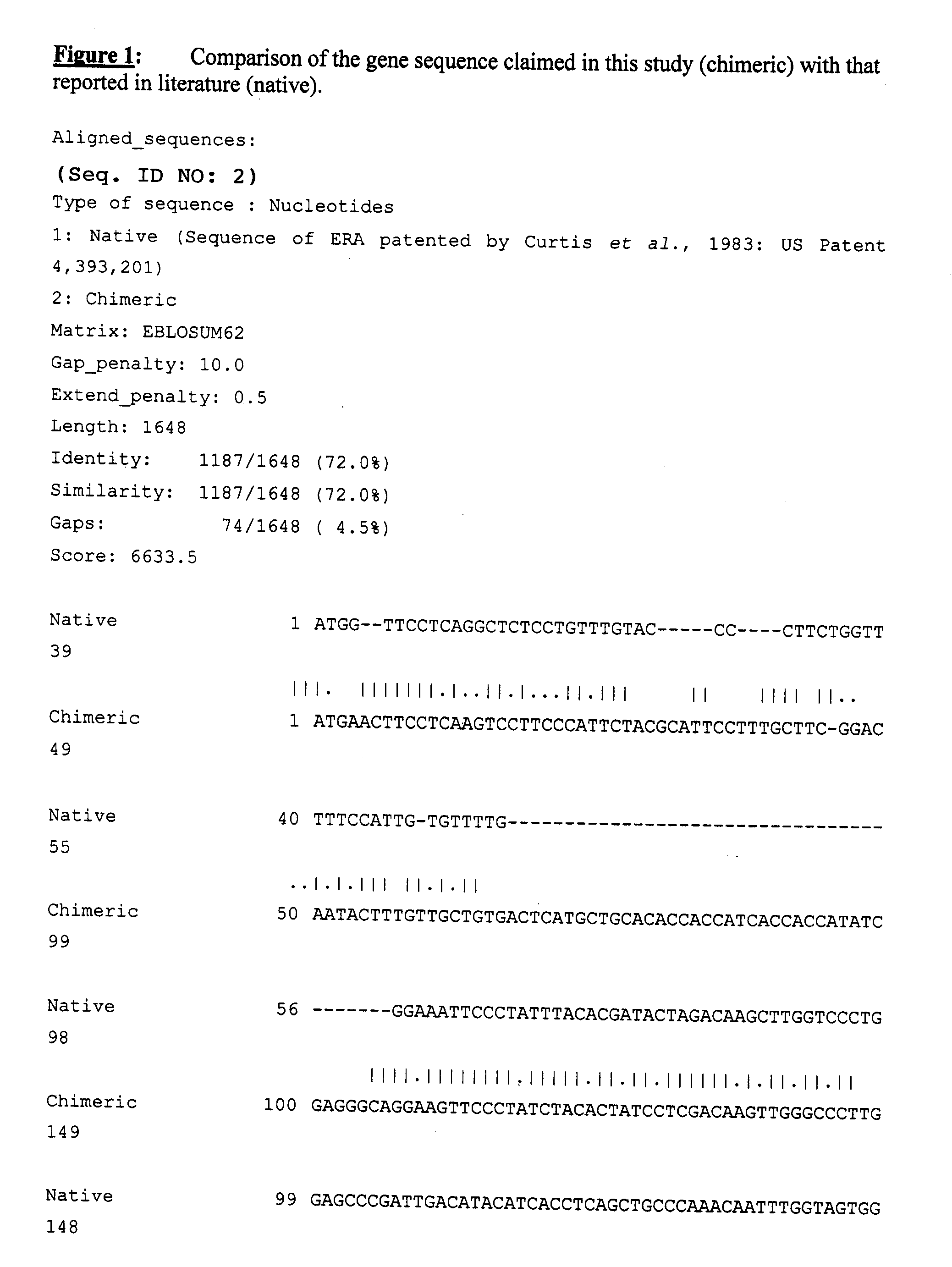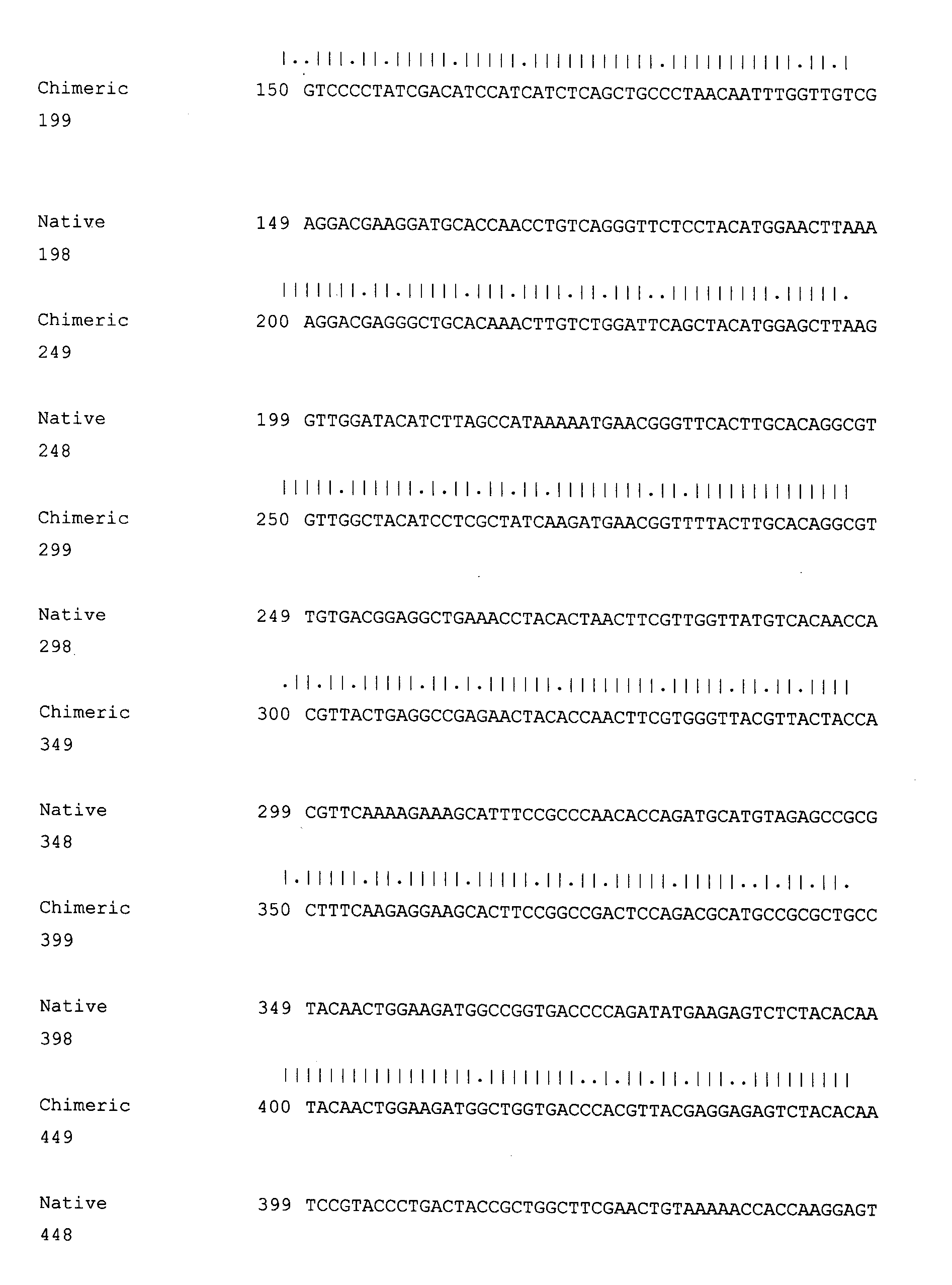Chimeric G protein based rabies vaccine
a rabies vaccine and chimeric g protein technology, applied in the direction of viruses, polypeptides with his-tags, peptides, etc., can solve the problems of lethal encephalomyelitis, inactivated virus production cost is a major problem, and prove fatal
- Summary
- Abstract
- Description
- Claims
- Application Information
AI Technical Summary
Benefits of technology
Problems solved by technology
Method used
Image
Examples
example 1
Expression of the Chimeric Gene in Escherichia coli
[0099]A gene coding for the chimeric G protein of 547 amino acid residues length, herein said chimeric G protein was strategically designed (SEQ ID NO. 1). The native polypeptide domain (from position 1 to 19) of G protein was replaced with PR-S signal peptide of tobacco (from position 1 to 26). Following that, a hexapeptide of histidine amino acid a residues and tetrapeptide comprising the amino acid residues IEGR were included at the N-terminus of the gene in that order. Following the G protein coding sequence, a hexapeptide coding for SEKDEL for retention of the chimeric G protein in endoplasmic reticulum was included at the C-terminus extreme of the chimeric gene (SEQ ID NO. 1). A 1.67 kb nucleotide sequence was theoretically designed (SEQ ID NO. 2) to code for the above-mentioned chimeric G protein. Several 6-base cutter restriction enzyme sites were created in the designed gene. HindIII and SalI restriction sites were created...
example 2
Immunization of BalbC Mice with Plant Derived Vaccine
[0102]In order to establish efficacy of the novel chimeric G-protein in plants, a plant transformation vector was constructed for the development of transgenic plants. A plasmid pPK201 (having CaMV35S promoter with duplicated enhancer) was digested with HindIII to excise out CaMV35S promoter with the duplicated enhancer. The plasmid pSA17, containing the chimeric G-protein gene cloned at HindIII-SacI in Bluescript II SK+ (Stratagene, La Jolla, Calif.) was prepared as described in Example 1. The chimeric gene consists of 26 amino acid residues of PRS signal peptide of tobacco followed by six histidine residues, four amino acid residues for factor Xa cleavage site, 505 amino acid residues of matured ERA rabies Glycoprotein and six amino acid residues for endoplasmic reticulum retention signal at C′ terminus of the chimeric G-protein gene in that order (SEQ ID NO. 1). A 1.67 Kb, sequence was theoretically designed using plant preferr...
example 3
Immunoprotection Analysis of Immunized Mice
[0103]The efficacy of plant derived G protein was studied in immunoprotection by injecting the G enriched plant membrane fraction in mice and challenging it with live rabies virus. Mice were intraperitoneally injected by the G protein enriched membrane fraction of transgenic tobacco leaves and a commercially available killed rabies virus vaccine (as positive control Rabipur by Aventis Pharma Ltd.) and phosphate buffer saline (as negative control). As described in Example 2, boosters were given on 7, 14 and 28th day. At each stage a total of 25 μg of protein was injected. After the third booster, mice were intracerebrally challenged with 10×LD50 of live rabies virus and observed for the appearance of symptoms. After thirteen days of the challenge the result was noted down and are shown in the table 6 and FIG. 7.
TABLE 6Total no. ofMice%micesurvivedProtectionControl mice60 0Plant derived membrane33100%fraction enriched with GproteinCommerciall...
PUM
| Property | Measurement | Unit |
|---|---|---|
| Fraction | aaaaa | aaaaa |
| Solubility (ppm) | aaaaa | aaaaa |
| Digital information | aaaaa | aaaaa |
Abstract
Description
Claims
Application Information
 Login to View More
Login to View More - R&D
- Intellectual Property
- Life Sciences
- Materials
- Tech Scout
- Unparalleled Data Quality
- Higher Quality Content
- 60% Fewer Hallucinations
Browse by: Latest US Patents, China's latest patents, Technical Efficacy Thesaurus, Application Domain, Technology Topic, Popular Technical Reports.
© 2025 PatSnap. All rights reserved.Legal|Privacy policy|Modern Slavery Act Transparency Statement|Sitemap|About US| Contact US: help@patsnap.com



